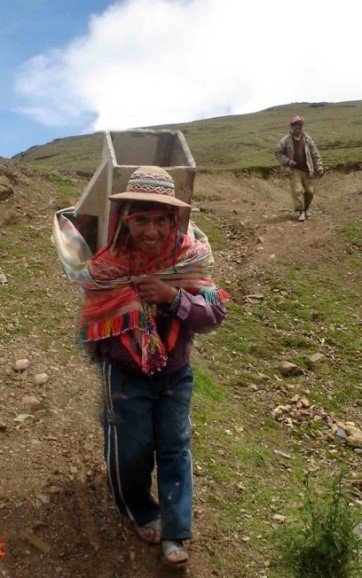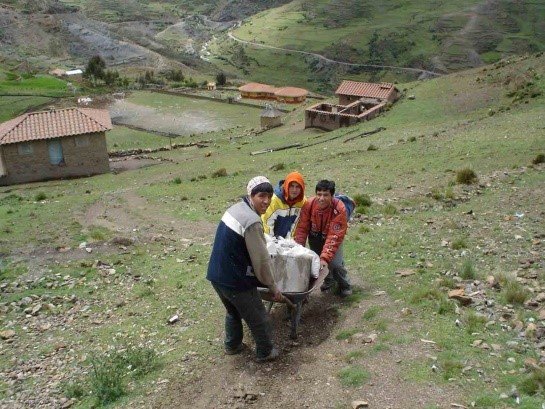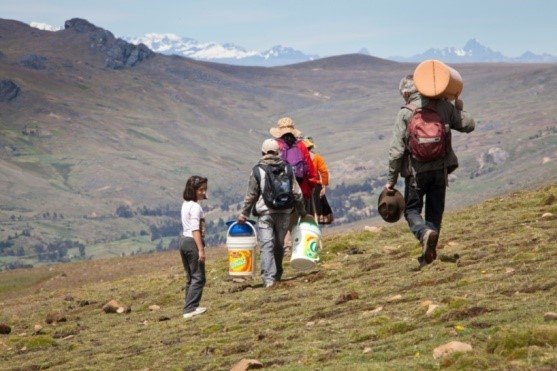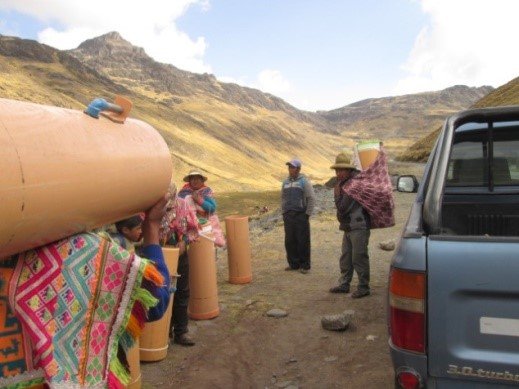By Sandra McGirr | Project Leader
At DESEA Peru, learning from our failure, was a great step forward; an advance which we literally carry on our backs. A key component of DESEA Peru's work with indigenous communities in the high Andes is provision of safe, household drinking water. Since its founding in 2008, DESEA has been installing biosand water filters in homes and schools, providing an effective, long-lasting, low maintenance water treatment system well suited to rural and remote communities.
The original biosand water filter was designed in the early 1990's by University of Calgary engineer, Dr. David Manz, and has been further developed and promoted worldwide by the Calgary-based Centre for Affordable Water and Sanitation Technology (CAWST). For DESEA's program in the Peruvian Andes, the challenge we faced with use of this highly successful water filter was the unwieldy, 95-kg weight of the filter body, which is constructed with concrete.
The concrete filter has the advantage of being able to be fabricated in communities with locally-available materials; however, transporting these heavy filters along steep, narrow mountain trails at elevations above 4000 metres (13,000 ft), proved to be overwhelmingly difficult. Maintaining high concrete quality with filters constructed in remote communities was also a challenge, and leaking filters were commonplace. A further, unexpected complication was that families would often have to move their filters, upon rebuilding or enlarging their homes, and this relocation would frequently cause breakage of the filters. Nevertheless, without an alternative filter body available, DESEA installed 150 concrete filters in isolated homes.
After two years of installing concrete filters, then-President, and Water Program Manager, Sandy Hart, was determined to make a lightweight, highly durable filter that could be easily carried to remote Andean communities, and also be suitable for inaccessible areas elsewhere. Using the design of the CAWST filter, Sandy started experimenting with materials and containers that were readily available in Peru. The filter body he developed used a 315-mm (12-inch) diameter PVC pipe, such as are used for water supply and drainage throughout Peru (as well as globally). This design, which adhered to the geometry of the CAWST concrete filter, weighed only 10 kg and could be fabricated in DESEA's shop at a cost of US $50. Testing of filter hydraulics and water quality indicated this PVC filter functioned identically to the CAWST filter.
CAWST engineers have visited DESEA Peru's operations on several occasions, providing support for DESEA's programs. As a result of this involvement, the DESEA PVC filter has been trialed in other areas where it is less feasible to install concrete filters, including the Peruvian Amazon, Bolivia, Afghanistan, and Palestine.
To date, more than 440 PVC biosand water filters have been installed in DESEA Peru project areas with high rates of correct usage (with special thanks to the local women serving as DESEA's community health workers). To enable others to use this design, DESEA has produced a construction and installation manual for its PVC filter, available at www.deseaperu.org/downloads. With the new design, DESEA is now able to move its program to more isolated areas, providing clean drinking water to those, for whom in the past, this could have only been a pipe dream.
This project report is a submission to GlobalGiving's 2017 Fail Forward Contest, where organizations are asked to share a story of when they tried something new that didn't go as planned and how they learned from it. Enjoy!
Links:
Project reports on GlobalGiving are posted directly to globalgiving.org by Project Leaders as they are completed, generally every 3-4 months. To protect the integrity of these documents, GlobalGiving does not alter them; therefore you may find some language or formatting issues.
If you donate to this project or have donated to this project, you can receive an email when this project posts a report. You can also subscribe for reports without donating.





